Properties
| Storage Buffer | PBS pH7.4, 50% glycerol, 0.09% sodium azide *Storage buffer may change when conjugated |
| Storage Temperature | -20ºC, Conjugated antibodies should be stored according to the product label |
| Shipping Temperature | Blue Ice or 4ºC |
| Purification | Protein G Purified |
| Clonality | Monoclonal |
| Clone Number | N43/6 (Formerly sold as S43-6) |
| Isotype | IgG1 |
| Specificity | Detects ~77kDa. |
| Cite This Product | StressMarq Biosciences Cat# SMC-309, RRID: AB_2131718 |
| Certificate of Analysis | 1 µg/ml of SMC-309 was sufficient for detection of KCNQ4 in 10 µg of COS-1 cell lysate transiently expressing KCNQ4 by colorimetric immunoblot analysis using Goat anti-mouse IgG:HRP as the secondary antibody. |
Biological Description
| Alternative Names | DFNA 2 antibody, DFNA2 antibody, KCNQ 4 antibody, Kcnq4 antibody, KCNQ4_HUMAN antibody, KQT like 4 antibody, KQT-like 4 antibody, KV7.4 antibody, Potassium channel KQT like 4 antibody, Potassium channel subunit alpha KvLQT4 antibody, Potassium voltage gated channel KQT like protein 4 antibody, Potassium voltage gated channel KQT like subfamily member 4 antibody, Potassium voltage gated channel subfamily KQT member 4 antibody, Potassium voltage-gated channel subfamily KQT member 4 antibody, Voltage gated potassium channel subunit Kv7.4 antibody, Voltage-gated potassium channel subunit Kv7.4 antibody |
| Research Areas | Cancer, Ion Channels, Neuroscience, Potassium Channels, Voltage-Gated Potassium Channels |
| Cellular Localization | Basal Cell Membrane, Plasma Membrane |
| Accession Number | NP_004691.2 |
| Gene ID | 9132 |
| Swiss Prot | P56696 |
| Scientific Background | The protein encoded by this gene forms a potassium channel that is thought to play a critical role in the regulation of neuronal excitability (1), particularly in sensory cells of the cochlea (2). The current generated by this channel is inhibited by M1 muscarinic acetylcholine receptors and activated by retigabine, a novel anti-convulsant drug (3). |
| References |
1. Hernandez C.C., Zaiko O., Tolstykh G.P., Shapiro M.S. (2008) J Physiol. 586(7): 1811-1821. 2. Kharkovets T., et al. (2006) EMBO J. 25(3): 642-652. 3. Tatulian L., Delmas P., Abogadie F.C., Brown D.A. (2001) J Neuroscience. 21(15): 5535-5545. |
Product Images
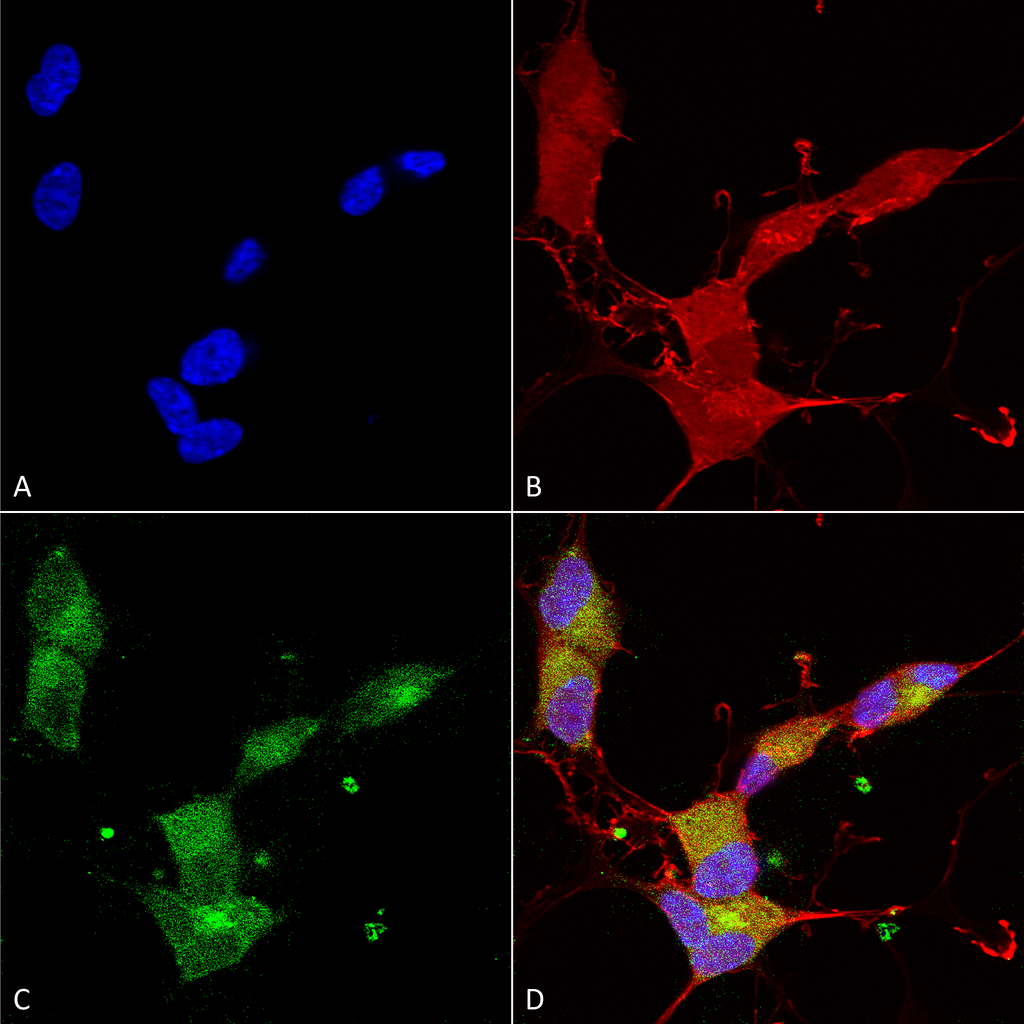
Immunocytochemistry/Immunofluorescence analysis using Mouse Anti-KCNQ4 Monoclonal Antibody, Clone N43/6 (SMC-309). Tissue: Neuroblastoma cells (SH-SY5Y). Species: Human. Fixation: 4% PFA for 15 min. Primary Antibody: Mouse Anti-KCNQ4 Monoclonal Antibody (SMC-309) at 1:100 for overnight at 4°C with slow rocking. Secondary Antibody: AlexaFluor 488 at 1:1000 for 1 hour at RT. Counterstain: Phalloidin-iFluor 647 (red) F-Actin stain; Hoechst (blue) nuclear stain at 1:800, 1.6mM for 20 min at RT. (A) Hoechst (blue) nuclear stain. (B) Phalloidin-iFluor 647 (red) F-Actin stain. (C) KCNQ4 Antibody (D) Composite.
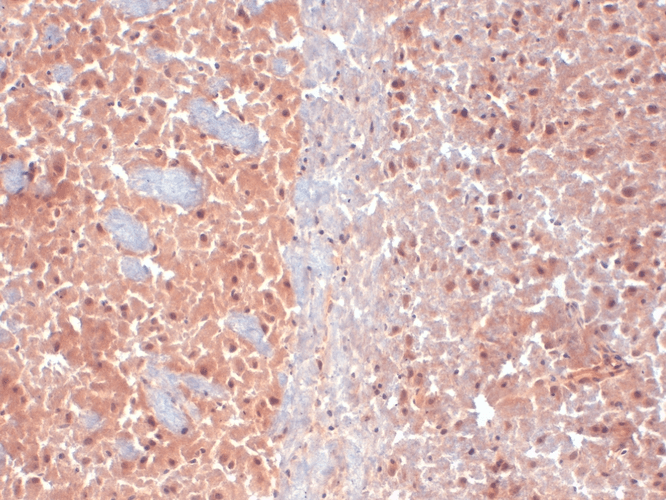
Immunohistochemistry analysis using Mouse Anti-KCNQ4 Monoclonal Antibody, Clone N43/6 (SMC-309). Tissue: frozen brain section. Species: Mouse. Fixation: 10% Formalin Solution for 12-24 hours at RT. Primary Antibody: Mouse Anti-KCNQ4 Monoclonal Antibody (SMC-309) at 1:1000 for 1 hour at RT. Secondary Antibody: HRP/DAB Detection System: Biotinylated Goat Anti-Mouse, Streptavidin Peroxidase, DAB Chromogen (brown) for 30 minutes at RT. Counterstain: Mayer Hematoxylin (purple/blue) nuclear stain at 250-500 µl for 5 minutes at RT.
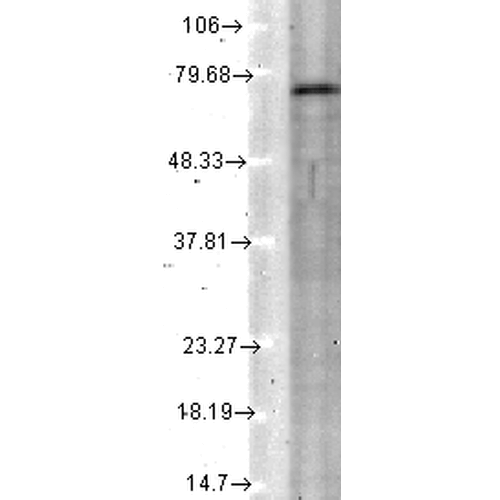
Western Blot analysis of Rat tissue lysate showing detection of KCNQ4 protein using Mouse Anti-KCNQ4 Monoclonal Antibody, Clone N43/6 (SMC-309). Load: 15 µg. Block: 1.5% BSA for 30 minutes at RT. Primary Antibody: Mouse Anti-KCNQ4 Monoclonal Antibody (SMC-309) at 1:1000 for 2 hours at RT. Secondary Antibody: Sheep Anti-Mouse IgG: HRP for 1 hour at RT.
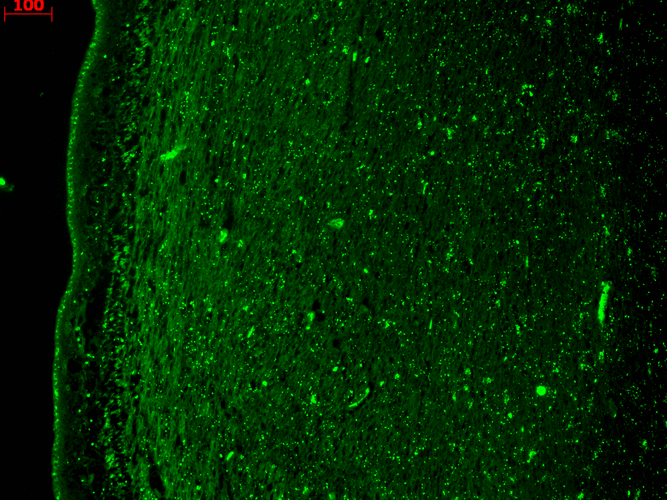
Immunohistochemistry analysis using Mouse Anti-KCNQ4 Monoclonal Antibody, Clone N43/6 (SMC-309). Tissue: hippocampus. Species: Human. Fixation: Bouin’s Fixative and paraffin-embedded. Primary Antibody: Mouse Anti-KCNQ4 Monoclonal Antibody (SMC-309) at 1:1000 for 1 hour at RT. Secondary Antibody: FITC Goat Anti-Mouse (green) at 1:50 for 1 hour at RT.

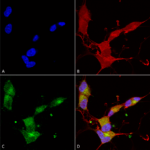




















StressMarq Biosciences :
Based on validation through cited publications.